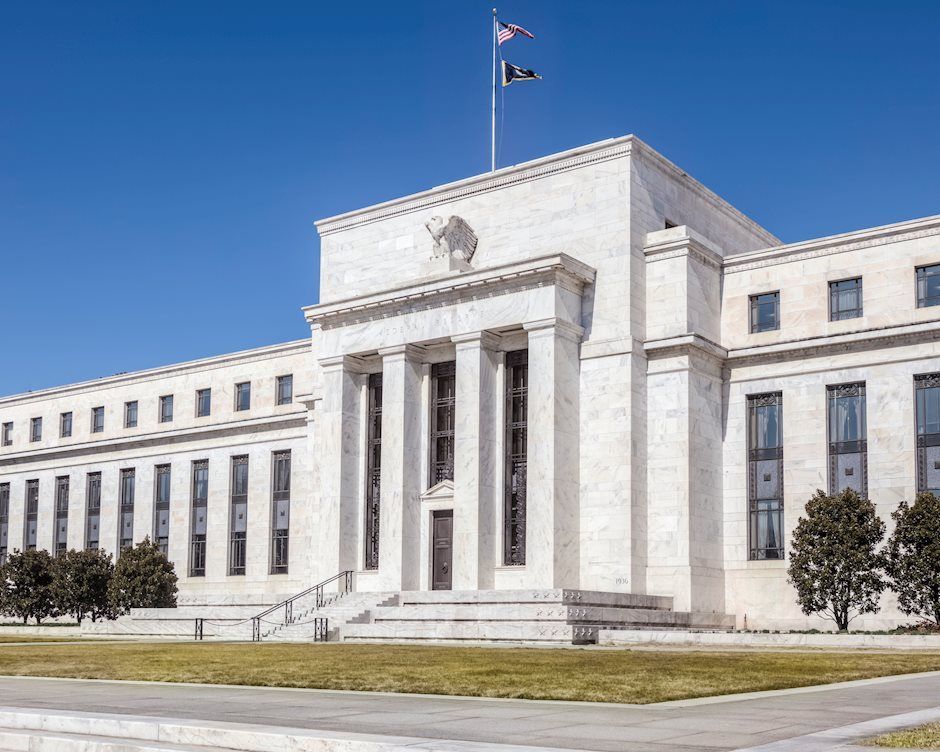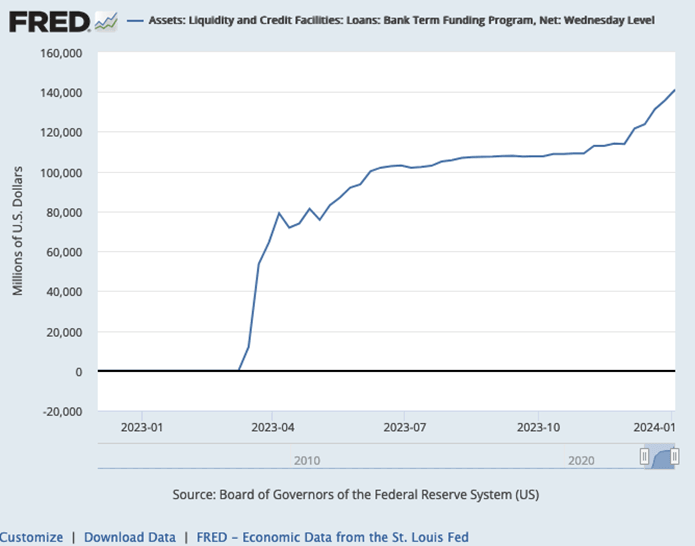Bank borrowing from Fed bailout program has surged

Is a U.S. banking crisis still bubbling under the surface?
If activity in the Federal Reserve’s bank bailout program is any indication, the answer to that question is yes.
Over the last two months, the balance in the Fed Bank Term Funding Program (BTFP) has surged, and the pace of borrowing appears to be increasing.
Since Nov. 19, the amount of outstanding loans in the BTFP has increased by $27.3 billion. The balance in the bailout program grew by nearly $5.4 billion in just the last week.
As of Jan. 3, the balance in the BTFP stood at just over $141.2 billion. It’s the largest balance since the program was created in March.
As you can see from the chart, borrowing had leveled off in August before the sudden spike in November. Keep in mind that banks were still tapping into the bailout even as the total balance in the program plateaued. Some banks were paying off loans as others borrowed.
This surge in bank bailout borrowing may indicate more banks are struggling in this high interest rate environment, and that the financial crisis that kicked off in March is still bubbling under the surface.
A sweetheart deal
The BTFP program is a sweetheart deal for banks struggling to raise short-term capital.
After the collapse of Silicon Valley Bank and Signature Bank last March, the Fed created the BTFP, allowing banks to easily access cash “to help assure banks have the ability to meet the needs of all their depositors."
Through this lending facility, banks, savings associations, credit unions, and other eligible depository institutions can take out short-term loans (up to one year) using U.S. Treasuries, agency debt and mortgage-backed securities, and other qualifying assets as collateral.
That’s where the sweetheart deal comes in. Instead of valuing these collateral assets at their market value, banks can borrow against them “at par” (Face value).
Since the Fed started raising interest rates, bond prices have dropped precipitously. The amount banks can borrow based on the current market value of their bond portfolios is much less than what they can borrow when the Fed values the collateral at par. In other words, the BTFP allows banks to borrow more than they otherwise could due to the big drop in bond prices over the last year-plus.
According to a Federal Reserve statement, “the BTFP will be an additional source of liquidity against high-quality securities, eliminating an institution’s need to quickly sell those securities in times of stress.”
Quickly selling securities in a time of stress is exactly what sank Silicon Valley Bank (SVB).
Things started to unravel when SVB sold a large portion of its bond portfolio at a $1.8 billion loss. At the time, SVB CEO Greg Becke said the bank made the sale “because we expect continued higher interest rates, pressured public and private markets, and elevated cash burn levels from our clients.”
The bank bought the bonds when interest rates were low. As a result, the bank’s $21 billion available for sale (AVS) bond portfolio was not yielding above cash burn. Meanwhile, rising interest rates caused the value of the portfolio to fall significantly. The plan was to sell the longer-term, lower-interest-rate bonds and reinvest the money into shorter-duration bonds with a higher yield. Instead, the sale dented the bank’s balance sheet and caused worried depositors to pull funds out of the bank.
The BTFP was put in place to give other banks an option to quickly raise capital against their bond portfolios without realizing big losses in an outright sale. It gives banks a way out, or at least the opportunity to kick the can down the road for a year. Instead of selling bonds that have dropped in value at a big loss, banks can go to the Fed and borrow money at the bonds’ face value.
The question is why are banks still tapping into this program nearly 10 months later?
Papering over the problem
It could be that banks are simply taking advantage of the situation and availing themselves of relatively low interest rate loans with ultra-loose collateral requirements. Or it could be that banks are still struggling in this high interest rate environment.
According to the FDCI, unrealized losses on securities climbed to $683.9 billion in Q3. That represented a 22.5 percent jump from the second quarter. Rising mortgage rates reducing the value of mortgage-backed securities drove the increase.
Banks face other problems as well. Loan losses were up 33.2 percent year-on-year in Q3 2023, and bank deposits contracted 4.8 percent through the first half of last year.
The BTFP bailout program allows banks to paper over these problems.
In the first week of the BTFP, banks borrowed $11.9 billion from the program, along with more than $300 billion from the already-established Fed Discount Window.
The Discount Window requires banks to post collateral at face value and loans come with a relatively high interest rate and must post collateral at fair market value. While Discount Window borrowing surged in the weeks after the collapse of SVB and Signature Bank, the balances were quickly paid back down, and Discount Window borrowing returned to normal levels.
You would expect borrowing from a bailout program to slow down considerably once the crisis passed. But banks never stopped tapping into the BTFP. And borrowing suddenly accelerated in November.
So, is it possible the crisis hasn’t passed?
It’s important to note that $141 billion in loans outstanding in the BTFP is insignificant in the context of $22.8 trillion in assets held by commercial banks in the U.S. The fact that banks are still tapping into a bailout program 10 months after the crisis doesn’t necessarily mean the banking system is on the verge of collapse.
But while bailout borrowing might not be a fire, there is at least smoke. It is entirely possible that there are still problems in the banking system bubbling under the surface. But they are out of sight out of mind thanks to the Fed.
The Fed is breaking things
Whether the mainstream realizes it or not, the Federal Reserve is breaking things in the economy with its higher interest rates. The banking crisis last spring was the first sign of trouble, but it almost certainly won’t be the last.
This is a predictable consequence of the Fed raising interest rates to battle price inflation.
Artificially low interest rates and easy money are the mother’s milk of this bubble economy. With everybody from corporations, consumers, and the federal government buried in debt, this economy and the financial system simply can’t function long-term in a high interest rate environment. The banking crisis earlier this year was the first thing to break as a result of rising interest rates. Other things will follow.
While you might be tempted to blame the Fed’s recent rate hikes for these issues, the real problem started years ago
After the Great Recession, Federal Reserve policy intentionally incentivized borrowing to “stimulate” the economy. It cut rates to zero and launched three rounds of quantitative easing. After an unsuccessful attempt to normalize rates and shrink its balance sheet in 2018, the Fed doubled down on easy money policies during the pandemic. This monetary inflation inevitably led to price inflation. That forced the Fed to raise interest rates. The central bank appears to have cooled price inflation (for now), but it also broke some banks.
In effect, the Fed managed to paper over the financial crisis with this bailout program. It basically slapped a band-aid on it. But it has not addressed the underlying issue – the impact of rising interest rates on an economy and financial system addicted to easy money
To receive free commentary and analysis on the gold and silver markets, click here to be added to the Money Metals news service.
Author

Mike Maharrey
Money Metals Exchange
Mike Maharrey is a journalist and market analyst for MoneyMetals.com with over a decade of experience in precious metals. He holds a BS in accounting from the University of Kentucky and a BA in journalism from the University of South Florida.


















